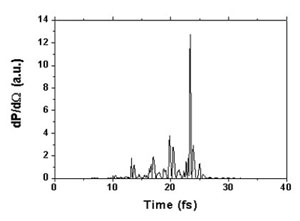|
2. METHODS
The calculation is carried out with the XOOPIC code, a 2D particle-in-cell (PIC) code, which were written by the researchers of the U. C. Berkeley. The far field radiation is calculated with our code from the electron dynamics achieved from the PIC calculation.
3. SUMMARY
RNTS is a scheme which describe the generation of attosecond pulses by the femtosecond laser interaction with a electron. A thinfilm target is required to satisfy a coherence condition. Then, the effect of the Coulomb field of the ions should be considered. The injection of a femtosecond laser to the thinfilm were calculated with the PIC model and it shows the generation of the attosecond pulse train. Some of the electrons shows a zigzag motion, which is typical in the RNTS phenomena. It is known that the attosecond pulse train can be generated by the interaction of the ion and laser field with the electron, so the origin of the pulses were investigated. The electrons that escape far away from the thin film, which means less affected by the ion, radiate strong attosecond pulses. It means that the RNTS scheme has a roll to the attosecond pulse radiation by a fs laser interaction with a thin film.

Fig. 1 The process of injection and reflection of the femtosecond laser pulse and the attosecond pulse train.
4. RESEARCH SIGNIFICANCE
The attosecond XUV pulses allows to investigate the atomic dynamics, like the femtosecond laser allow to trace the detail of chamical reactions. Until now, the interaction of a femtosecond laser with noble gas has been used to generate the attosecond pulse but it has limits of the intensity and wavelength. Therefore, the surface high-order harmonic generation(HHG), which is a interaction of a laser with a solid surface, is regarded as an alternative.

Fig. 2 Calculated attosecond pulse train from the femtosecond laser interaction with a thinfilm.
With the RNTS scheme, attosecond pulses are generated from the interaction of a laser and a electron. It can be demonstrated as an experiment when a thin film target is provided and it can be a used to generate attosecond pulse as a surface HHG method. 5. FUTURE RESEARCH PLANS
1. More short attosecond pulse can be achieved with thinner film with the optimization of calculation code or more calculation power.
2. When a good condition to generate attosecond pulse is estimated in the calculation, the experiment can be planed.
| 
